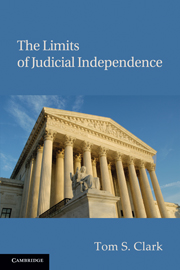Book contents
- Frontmatter
- Contents
- List of Tables
- List of Figures
- Acknowledgments
- 1 Introduction
- 2 A Political History of Court-Curbing
- 3 Conditional Self-Restraint
- 4 Court-Curbing and the Electoral Connection
- 5 Public Support and Judicial Review
- 6 Ideological Implications of Court-Curbing
- 7 The Limits of Judicial Independence
- Appendix A Elite Interview Methodology
- Appendix B Court-Curbing Bills, 1877–2008
- Bibliography
- Index
4 - Court-Curbing and the Electoral Connection
Published online by Cambridge University Press: 05 August 2012
- Frontmatter
- Contents
- List of Tables
- List of Figures
- Acknowledgments
- 1 Introduction
- 2 A Political History of Court-Curbing
- 3 Conditional Self-Restraint
- 4 Court-Curbing and the Electoral Connection
- 5 Public Support and Judicial Review
- 6 Ideological Implications of Court-Curbing
- 7 The Limits of Judicial Independence
- Appendix A Elite Interview Methodology
- Appendix B Court-Curbing Bills, 1877–2008
- Bibliography
- Index
Summary
In 1954, during a period of relative harmony in Washington, no Court-curbing bills were introduced in Congress. In fact, during the ten preceding years, only fourteen Court-curbing bills had been introduced. However, 1955 and 1956 would witness a slight increase in the introduction of anti-Court bills (six and five, respectively), and in 1957, thirteen such bills would be introduced, and fifteen bills were introduced in 1959. A decade later, in 1969, at least fifty-three Court-curbing bills were introduced. What explains the decision to introduce Court-curbing legislation in Congress? What is the source of anti-Court sentiment among legislators? The theory developed in the preceding chapter suggested a number of factors that should determine the extent of Court-curbing in Congress, and in this chapter, we ask whether the historical patterns support those predictions.
The Conditional Self-Restraint Model predicts that the introduction of Court-curbing bills will be driven by both public opinion and policy disagreements between Congress and the Supreme Court. Importantly, it is the public opinion motivation behind Court-curbing that allows it to be a credible signal about the Court's institutional legitimacy and diffuse support. In subsequent chapters, we will consider whether the Court responds to the introduction of Court-curbing bills, but here we first establish the determinants of Court-curbing. In the end, the analysis will demonstrate that public discontent with the Court is the primary determinant of Court-curbing, while policy divergence between the Court and Congress also influences Court-curbing.
- Type
- Chapter
- Information
- The Limits of Judicial Independence , pp. 122 - 158Publisher: Cambridge University PressPrint publication year: 2010

